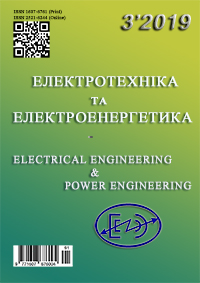TECHNICAL AND ECONOMIC JUSTIFICATION OF COGENERATION TECHNOLOGY WITH THE USE OF ELECTROMOBILE
DOI:
https://doi.org/10.15588/1607-6761-2019-3-5Keywords:
renewable energy, green tariff, electric vehicles, co-generation, feasibility studyAbstract
Purpose. To evaluate the economic attractiveness of alternative energetics, and in particular Vehicle-to-grid (V2G) technology, i.e. the use of an electric vehicle battery for cogeneration into the network. Determine the economic indicators and conditions under which this technology will be attractive to electric vehicle owners
Methodology. The forecasts of the National Electricity Regulatory Commission of Ukraine, analytics data and manufacturers of electric vehicles were used to calculate economic indicators
Findings. The overview of the trends in alternative energetic in Ukraine and, in particular, electric mobility in the context of their economic feasibility is completed. The analysis of electricity tariffs received from renewed sources is carried out and the forecast for the share of alternative energy of Ukraine in the future is made. Aspects of V2G technology are considered - the use of electric vehicle battery as an intermediate energy storage, charging them during low nightly electricity tariff and return to the grid for partial coverage of peak load. It is shown that the shortening of the battery life due to the increase of charge-discharge cycles makes this idea incapable at the current level of cogeneration tariff.
Originality. It is proved that to increase the attractiveness of V2G technology for the electric vehicle owner, it is necessary to increase the capacity of electric vehicle batteries, to increase the capacity of charging and discharging devices and to increase the level of the «green» tariff or set a special tariff for cogeneration from electric vehicles.
Practical value. The numerical values of electricity tariffs and the parameters of charge-discharge of electric vehicle batteries necessary for the feasibility study of cogeneration technology from electric vehicle batteries to the power grid are given. The tariff limits and system parameters for which the V2G technology will become self-sufficient are determined..
References
[1] Car Maintenance. (2019). Retrieved from https://www.tesla.com/en_EU/support/car-maintenance?redirect=no [Accessed 6 Jun. 2019].
[2] Part 1: Instability in a Crucial Country: Stratfor geopolitical (2019). Retrieved from https://worldview.stratfor.com/article/part-1-instability-crucial-country
[3] Electricity Tariff in Ukraine: NERC Report Retrieved from http://www.nerc.gov.ua/?id=30038
[4] How Much Does Electricity Cost in France? (2019). Retrieved from https://en.selectra.info/energy-france/guides/electricity-cost
[5] Report of the State Agency for Energy Efficiency and Energy Conservation of Ukraine (2017) Retrieved from https://alteco.in.ua/about/news/korporativnye-novosti/215-statistika-po-chastnym-solnechnym-stanciyam-v-ukraine-na-konec-2017-goda - 2017
[6] Energy of the sun | Ukraine's State Energy Efficiency. (2019). Retrieved from http://saee.gov.ua/uk/ae/sunenergy
[7] Moves Toward Green Energy Hamper Germany's Economy. (2019). Retrieved from https://worldview.stratfor.com/article/moves-toward-green-energy-hamper-germanys-economy
[8] Ukraine is among the top 10 countries for the sale of electric motors https://www.epravda.com.ua/rus/news/2018/03/13/634925/
[9] Yazdanie, M., Noembrini, F., Dossetto, L., & Boulouchos, K. (2014). Corrigendum to «A comparative analysis of well-to-wheel primary energy demand and greenhouse gas emissions for the operation of alternative and conventional vehicles in Switzerland, considering various energy carrier production pathways» [Journal of Power Sources 249 (2014) 333–348]. Journal Of Power Sources, 256, 485-486. doi: 10.1016/j.jpowsour.2014.01.088
[10] Vehicle-to-grid. (2019). Retrieved from https://en.wikipedia.org/wiki/Vehicle-to-grid
[11] Electric vehicles in Europe: report of the European Environment Agency (2016). Retrieved from https://www.eea.europa.eu/publications/electric-vehicles-in-europe/download
[12] Energy of the Sun.. (2019). Retrieved from http://saee.gov.ua/uk/ae/sunenergy
[13] Arcus, C., & Arcus, C. (2019). Battery Lifetime: How Long Can Electric Vehicle Batteries Last? | CleanTechnica. Retrieved from https://cleantechnica.com/2016/05/31/battery-lifetime-long-can-electric-vehicle-batteries-last/
[14] Beshta, A., Aziukovskyi, O., Balakhontsev, A., & Shestakov, A. (2017). Combined power electronic converter for simultaneous operation of several renewable energy sources. 2017 International Conference On Modern Electrical And Energy Systems (MEES). doi: 10.1109/mees.2017.8248898
[15] Beshta, O., Balakhontsev, A., & Albu, A. (2013). Design of electromechanical system for parallel hybrid electric vehicle. Energy Efficiency Improvement Of Geotechnical Systems, 29-35. doi: 10.1201/b16355-5
Downloads
Published
How to Cite
Issue
Section
License
Copyright (c) 2019 A.S. Beshta, A.A. Aziukovski, E.P. Khudolii, S.S. Khudolii, O.V. Balakhontsev

This work is licensed under a Creative Commons Attribution 4.0 International License.
Creative Commons Licensing Notifications in the Copyright Notices
Authors who publish with this journal agree to the following terms:
Authors retain copyright and grant the journal right of first publication with the work simultaneously licensed under aCreative Commons Attribution License that allows others to share the work with an acknowledgement of the work's authorship and initial publication in this journal.
Authors are able to enter into separate, additional contractual arrangements for the non-exclusive distribution of the journal's published version of the work (e.g., post it to an institutional repository or publish it in a book), with an acknowledgement of its initial publication in this journal.
Authors are permitted and encouraged to post their work online (e.g., in institutional repositories or on their website) prior to and during the submission process, as it can lead to productive exchanges, as well as earlier and greater citation of published work.

